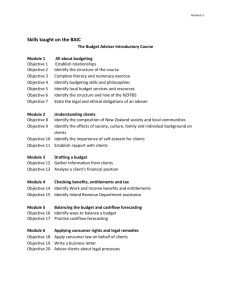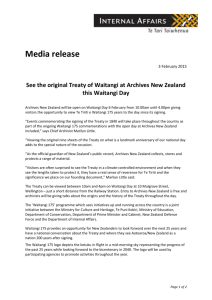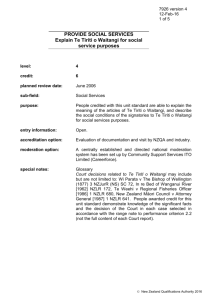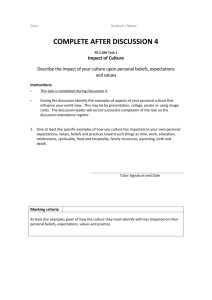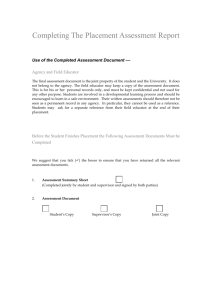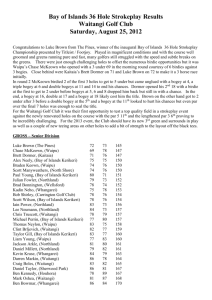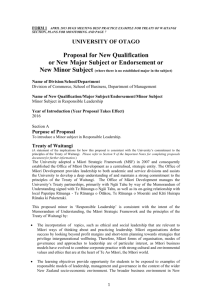ETA16843v4 - Careerforce
advertisement
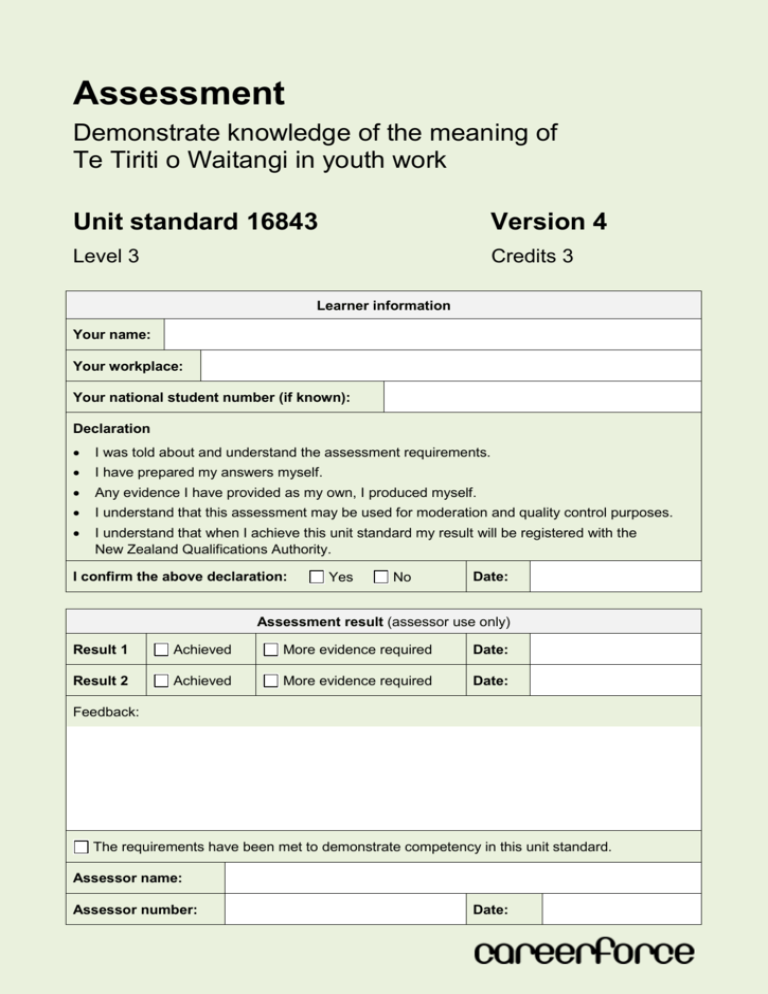
Assessment Demonstrate knowledge of the meaning of Te Tiriti o Waitangi in youth work Unit standard 16843 Version 4 Level 3 Credits 3 Learner information Your name: Your workplace: Your national student number (if known): Declaration I was told about and understand the assessment requirements. I have prepared my answers myself. Any evidence I have provided as my own, I produced myself. I understand that this assessment may be used for moderation and quality control purposes. I understand that when I achieve this unit standard my result will be registered with the New Zealand Qualifications Authority. I confirm the above declaration: Yes No Date: Assessment result (assessor use only) Result 1 Achieved More evidence required Date: Result 2 Achieved More evidence required Date: Feedback: The requirements have been met to demonstrate competency in this unit standard. Assessor name: Assessor number: Date: To demonstrate competency, you must be able to: Outcomes Tasks Describe personal knowledge of Te Tiriti o Waitangi. 1 1, 2, 6 Outline the meaning of the articles of Te Tiriti o Waitangi for youth work. 2 3–5 Instructions Your answers may be written (either electronically or by hand) or spoken. If you need help with this assessment please contact your assessor. Once you have completed your assessment, you must read and confirm the declaration on the cover page. Filled in or written answers If there are open white spaces on a page due to shorter answers, this is acceptable. You don’t have to fill the space. If you write your answers, use a pen. If you need to change your answer, write your initials beside any corrections you make. If you need more space, attach extra pages with your answer. Add your name and task number to all extra pages you use. Verbal answers If you answer verbally, your assessor will write your answer(s), or may use a voice recorder. Definitions The learner is you, the person being assessed (you may also be referred to as the trainee, student, candidate or employee in some instances). The assessor is the person who will assess you. The verifier is a workplace supervisor, team leader, manager or assessor who understands the assessment, works closely with you and can confirm that you have completed a task competently. Important notes Māori version, in this assessment, is either the Māori version of Te Tiriti o Waitangi, or an approved English translation of the Māori version of Te Tiriti o Waitangi. Resources This is an open book assessment. The following learning resources may be useful when completing this assessment: the Careerforce learning resource for this unit standard. learning materials, books, the internet and your workplace policies and procedures. the references listed at the back of this assessment. US 16843 version 4 – Assessment – Meaning of Te Tiriti O Waitangi in youth work © Careerforce 2013 – Issue 1.4 – Published Jul 2013 2 Task 1: Previous knowledge 1. Describe what you knew about Te Tiriti o Waitangi before this assessment. Enter your answer here 2. Describe which sources of information you used to gain this knowledge. Enter your answer here Task 1 result: US 16843 version 4 – Assessment – Meaning of Te Tiriti O Waitangi in youth work © Careerforce 2013 – Issue 1.4 – Published Jul 2013 Achieved More evidence required 3 Task 2: Past personal response 1. Describe how you have responded to Te Tiriti o Waitangi before this assessment. Enter your answer here 2. Describe how the sources of information influenced how you responded. Enter your answer here 3. How did previous experiences influence how you responded? Enter your answer here Task 2 result: US 16843 version 4 – Assessment – Meaning of Te Tiriti O Waitangi in youth work © Careerforce 2013 – Issue 1.4 – Published Jul 2013 Achieved More evidence required 4 Task 3: Intentions for signing 1. Provide reasons why Māori and the Crown wanted to sign Te Tiriti o Waitangi. Enter your answer here Task 3 result: US 16843 version 4 – Assessment – Meaning of Te Tiriti O Waitangi in youth work © Careerforce 2013 – Issue 1.4 – Published Jul 2013 Achieved More evidence required 5 Task 4: Differences in meaning 1. Identify differences in meaning between the English version and the Te Reo Māori version of the articles of Te Tiriti o Waitangi. Enter your answer here Task 4 result: US 16843 version 4 – Assessment – Meaning of Te Tiriti O Waitangi in youth work © Careerforce 2013 – Issue 1.4 – Published Jul 2013 Achieved More evidence required 6 Task 5: Te Tiriti o Waitangi in youth work 1. Describe how Te Tiriti o Waitangi is relevant in the work you do with young people. Ensure you cover two of the following: relationships with tangata whenua. relationships with tauiwi. planning. policy. service delivery and provision. staffing. Enter your answer here Task 5 result: US 16843 version 4 – Assessment – Meaning of Te Tiriti O Waitangi in youth work © Careerforce 2013 – Issue 1.4 – Published Jul 2013 Achieved More evidence required 7 Task 6: Current personal response Describe what your current personal response to Te Tiriti o Waitangi is. Enter your answer here Task 6 result: US 16843 version 4 – Assessment – Meaning of Te Tiriti O Waitangi in youth work © Careerforce 2013 – Issue 1.4 – Published Jul 2013 Achieved More evidence required 8 References 1 Information on interpretation and meaning of Te Tiriti o Waitangi can be found on the Waitangi Tribunal’s website at: www.waitangi-tribunal.govt.nz/treaty/meaning.asp or on the Treaty 2 U website at: www.treaty2u.govt.nz/. Feedback Careerforce regularly reviews our assessment and learning resources. As a user, we would appreciate feedback on how you found it. Feedback can be provided to Careerforce via our online feedback form at www.careerforce.org.nz/productfeedback or if you would prefer to send us an email please send it to info@careerforce.org.nz US 16843 version 4 – Assessment – Meaning of Te Tiriti O Waitangi in youth work © Careerforce 2013 – Issue 1.4 – Published Jul 2013 9
